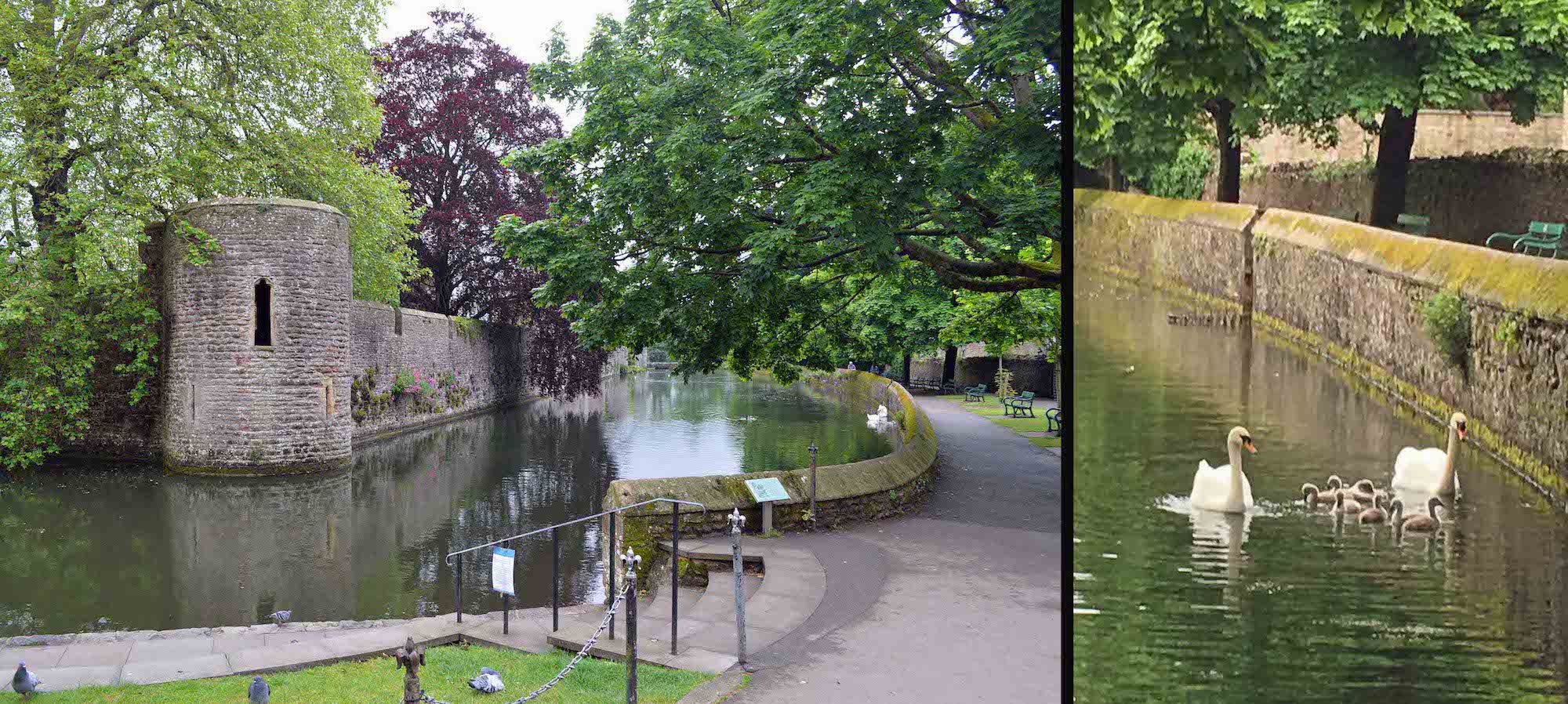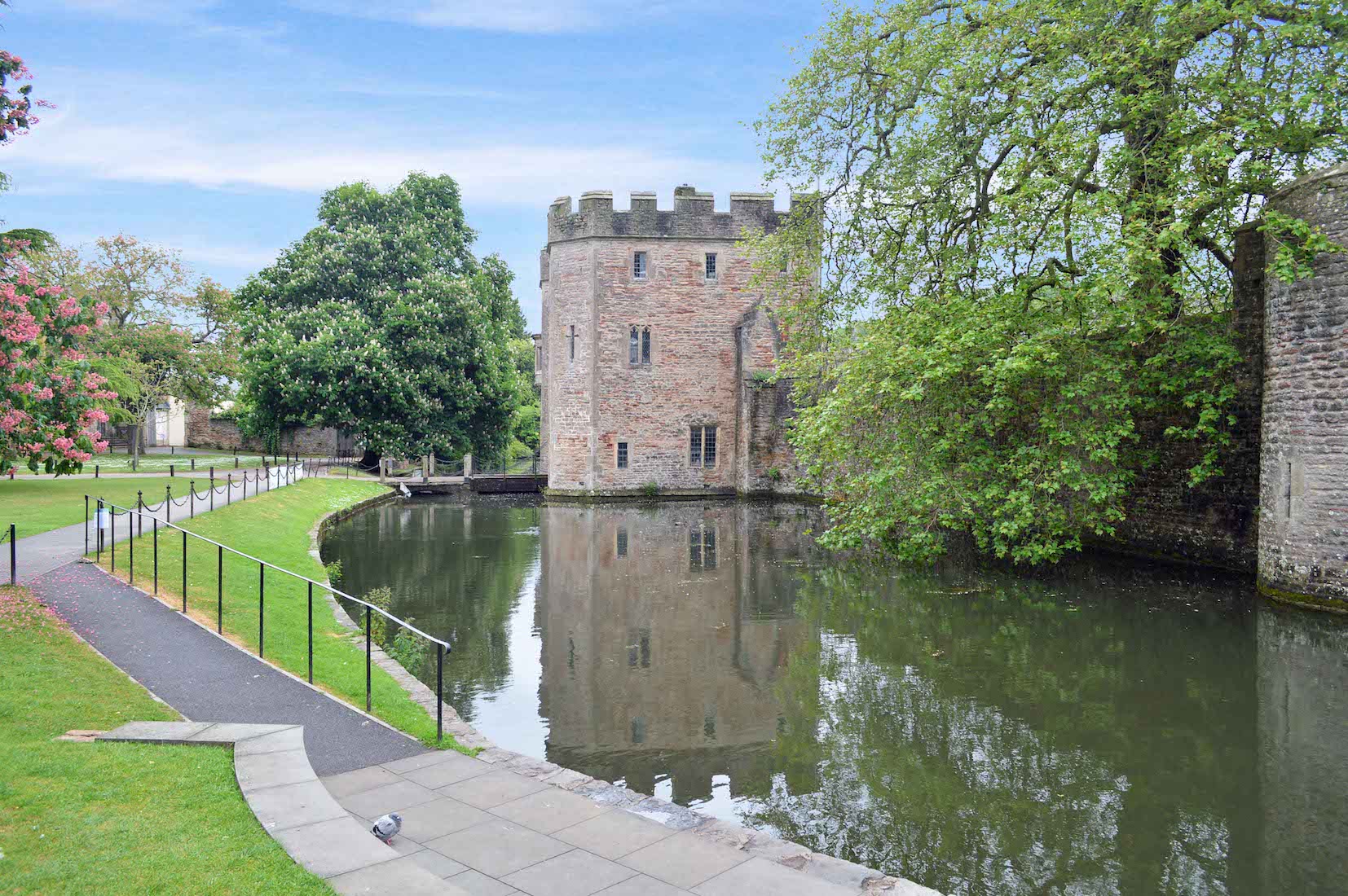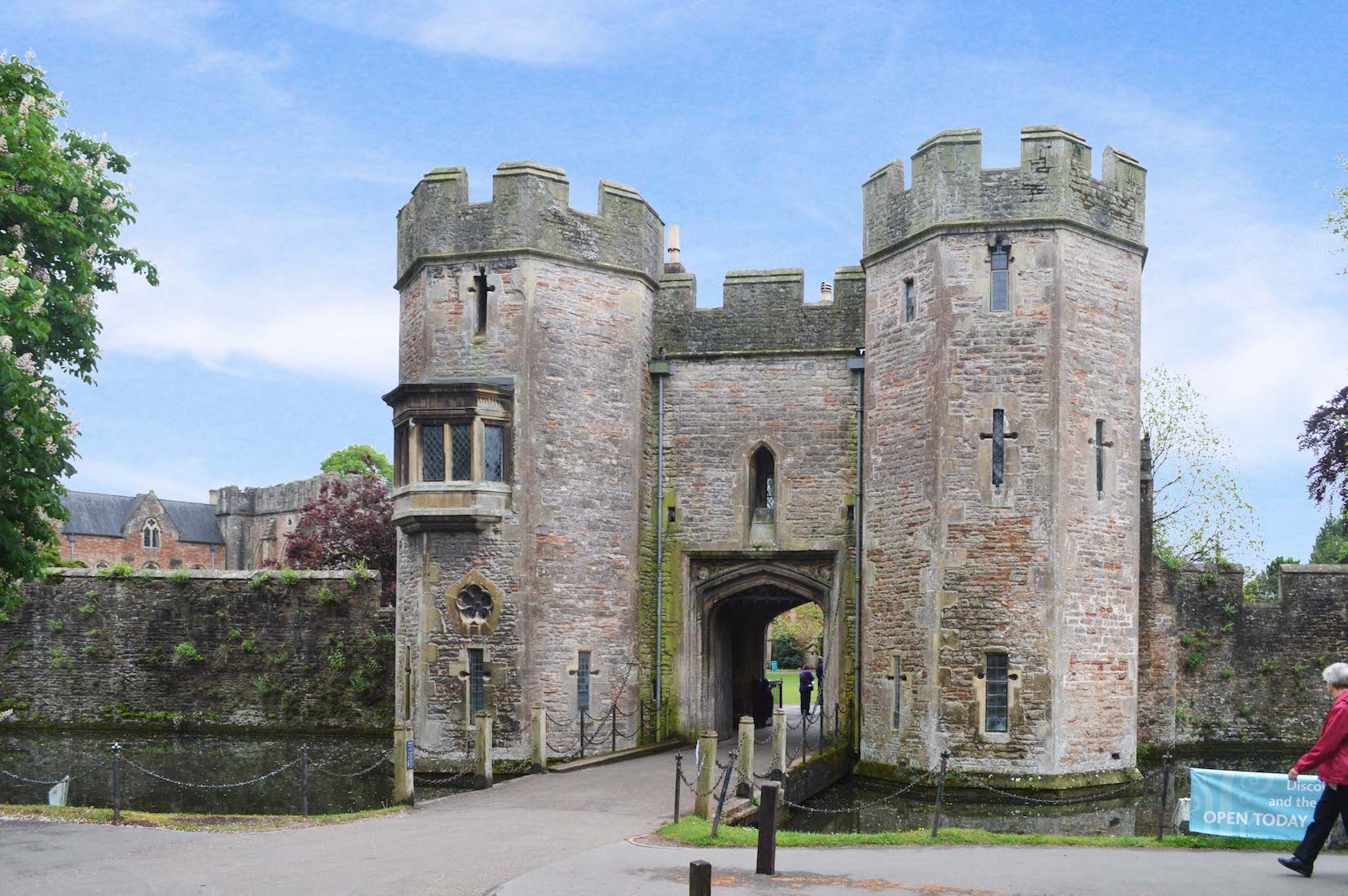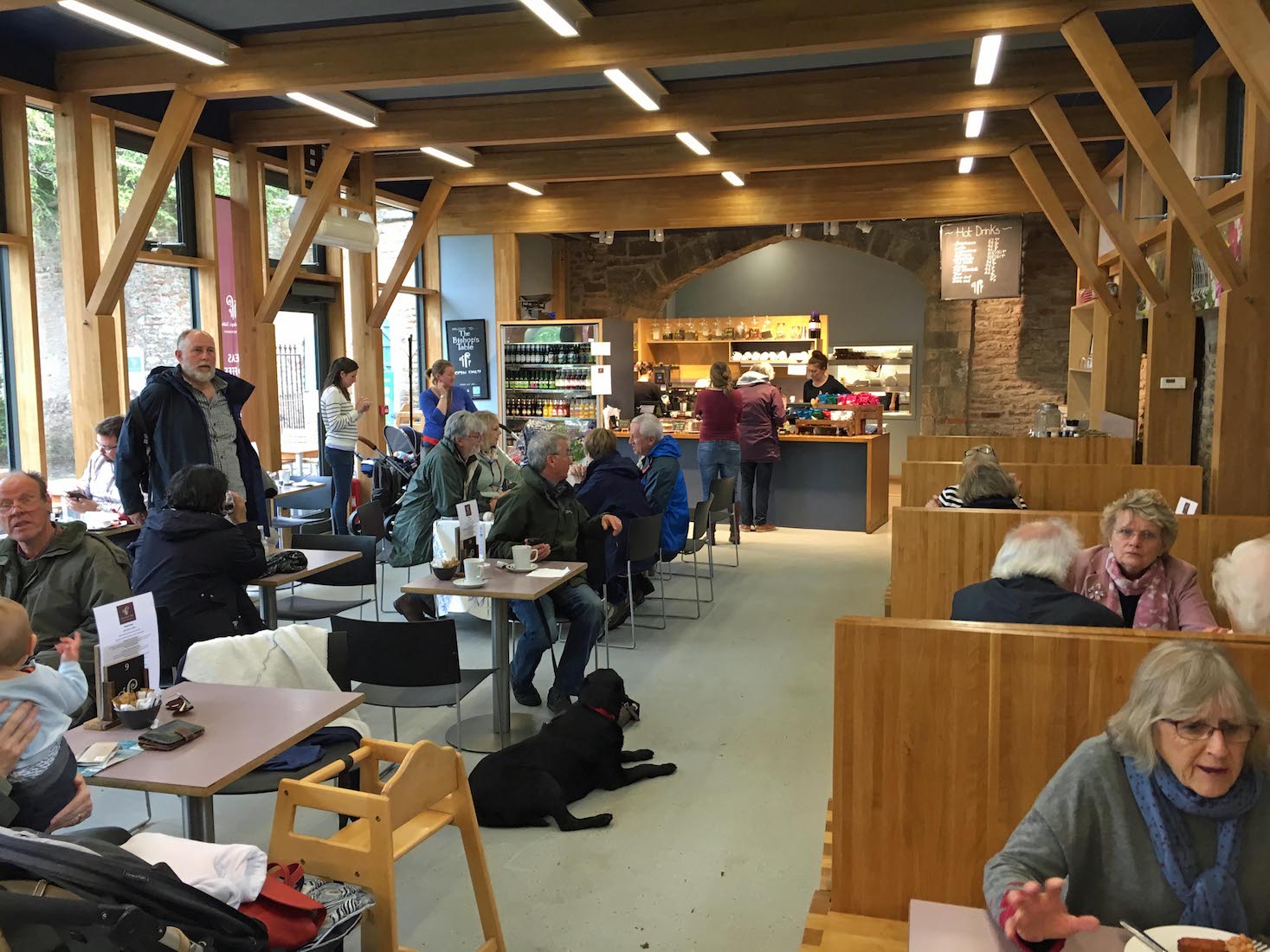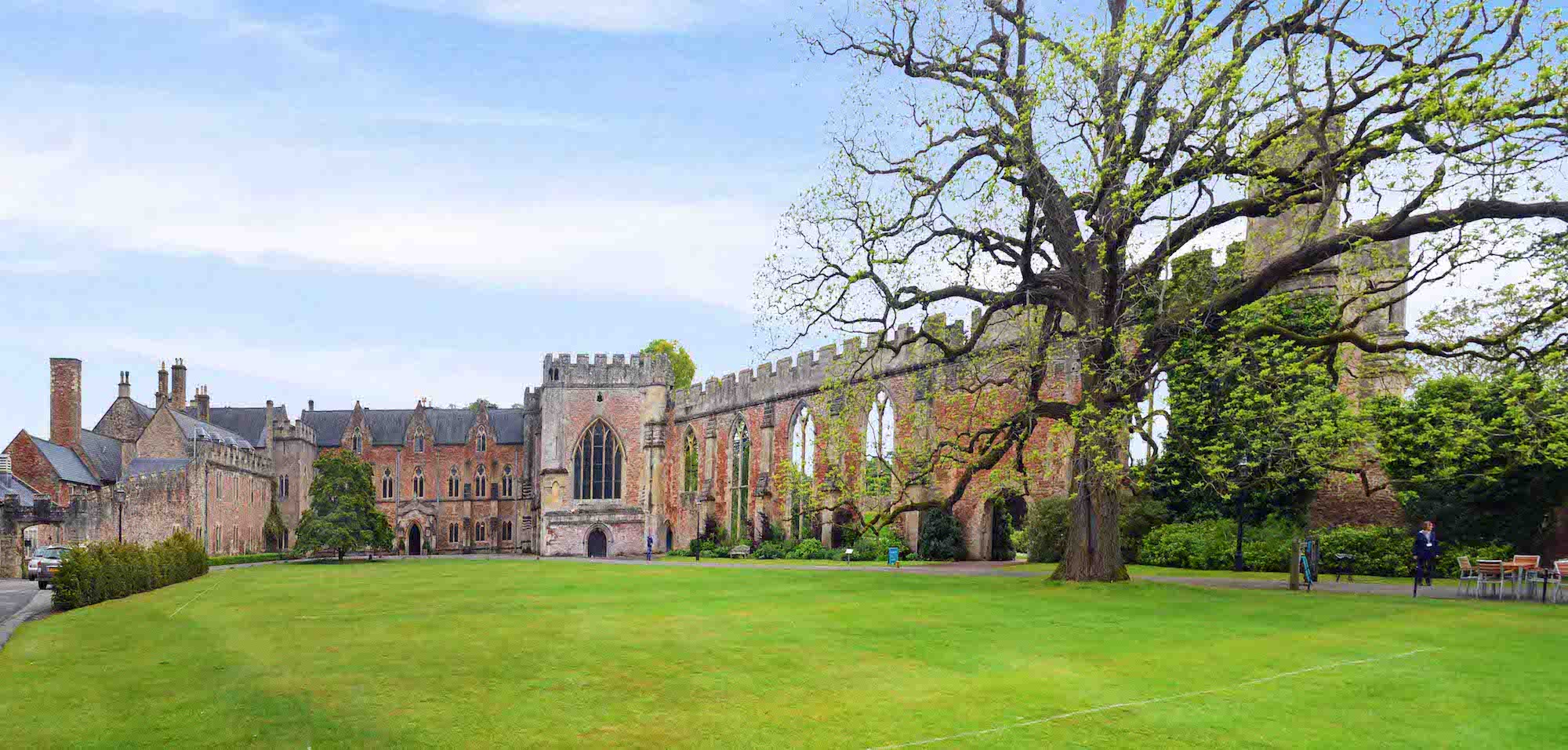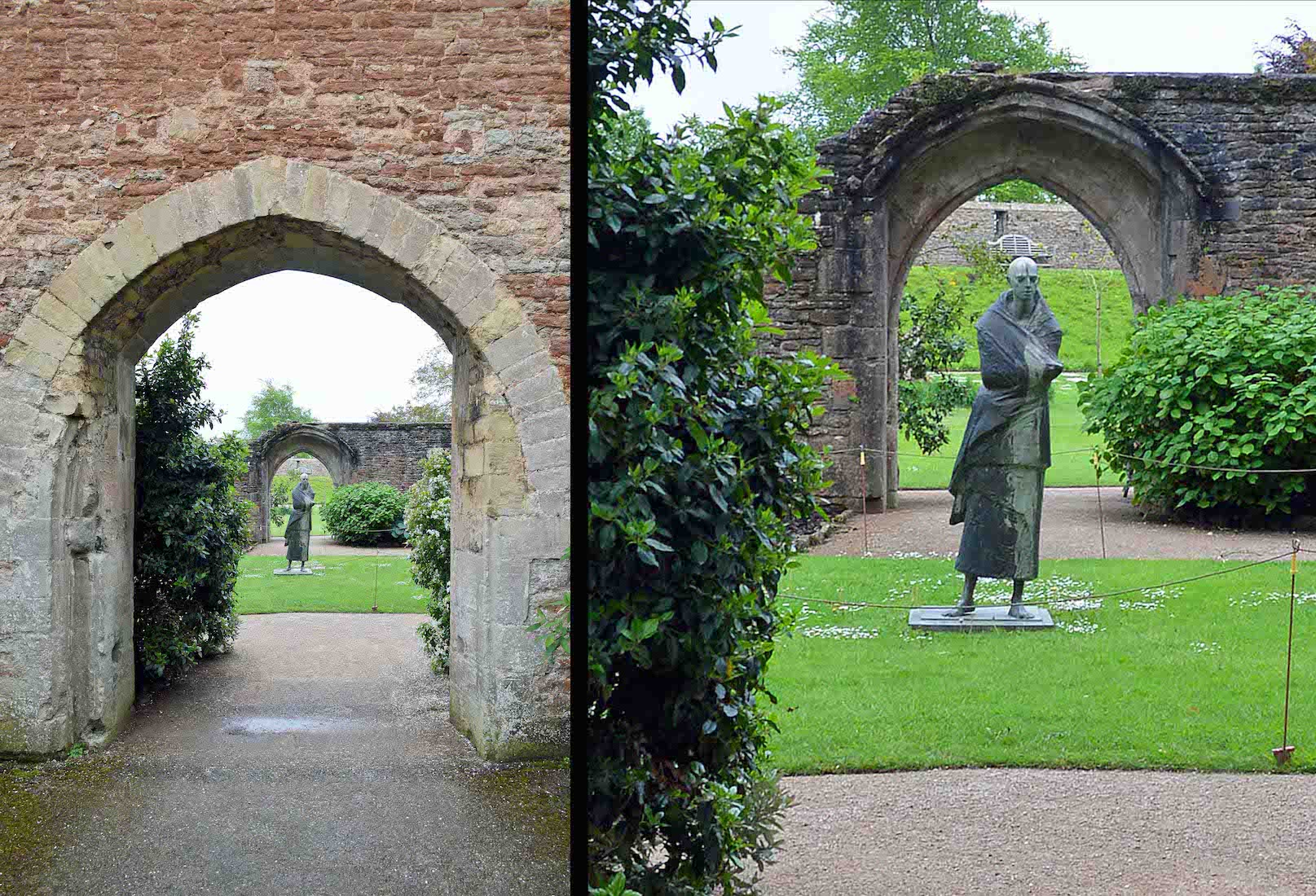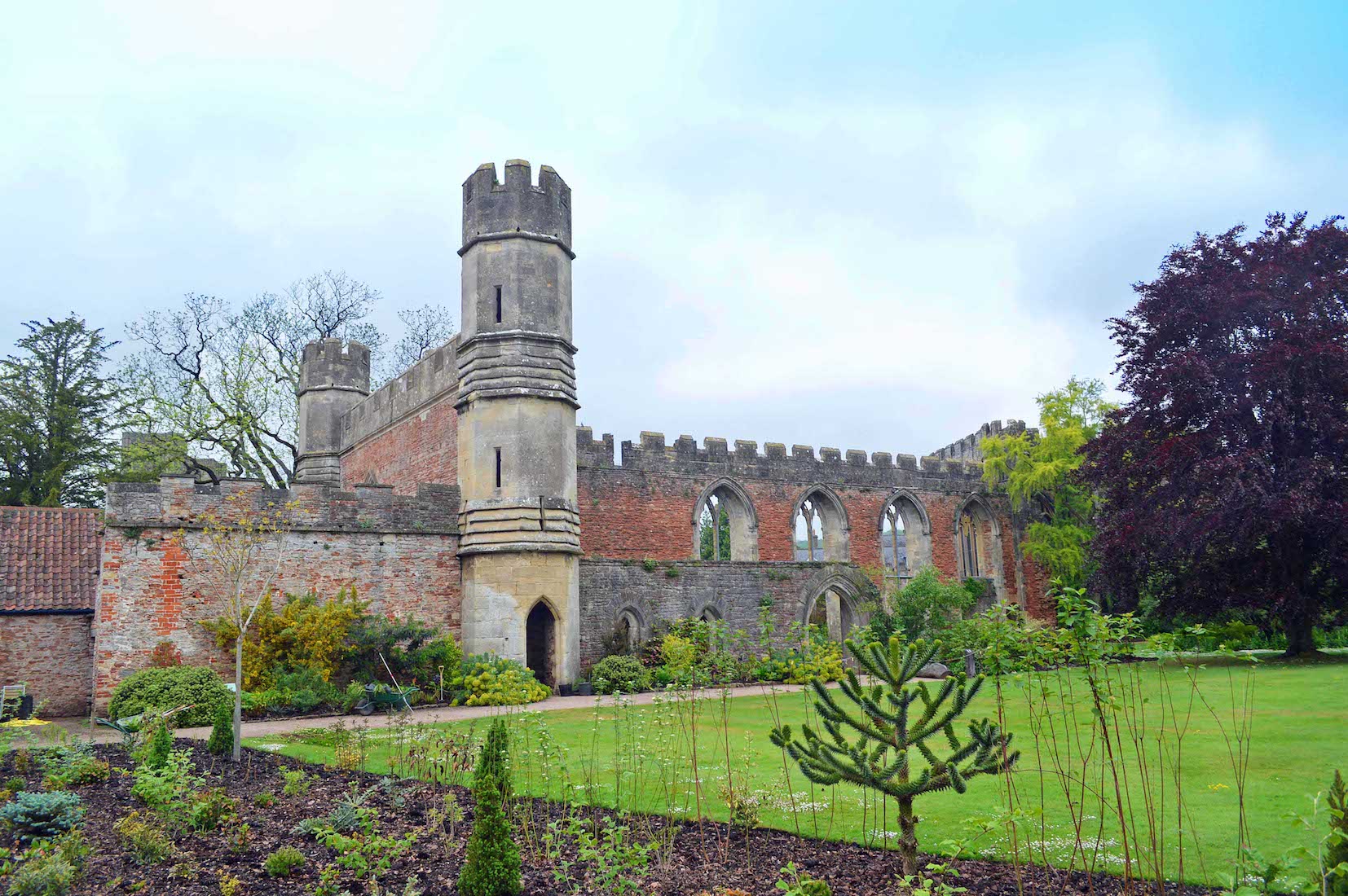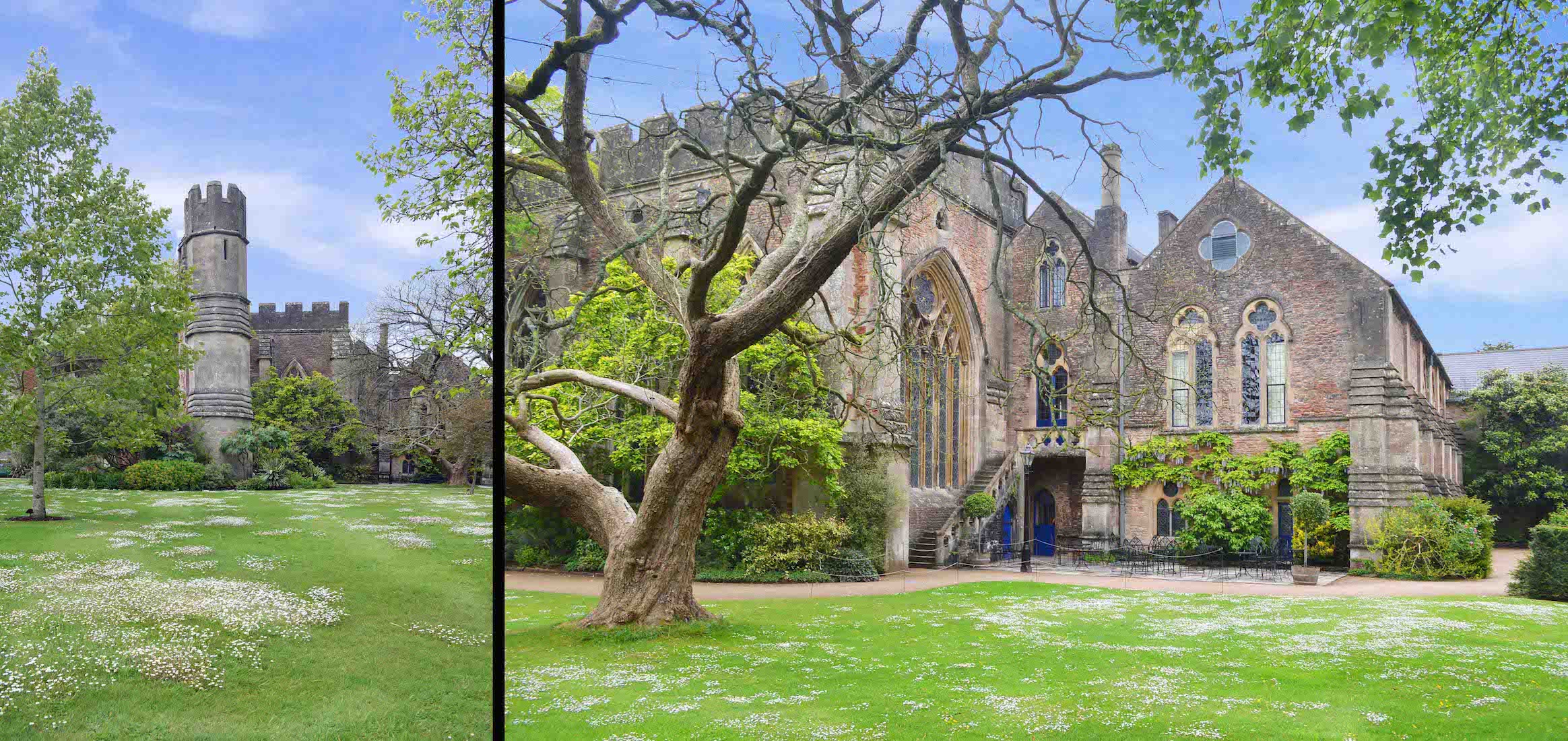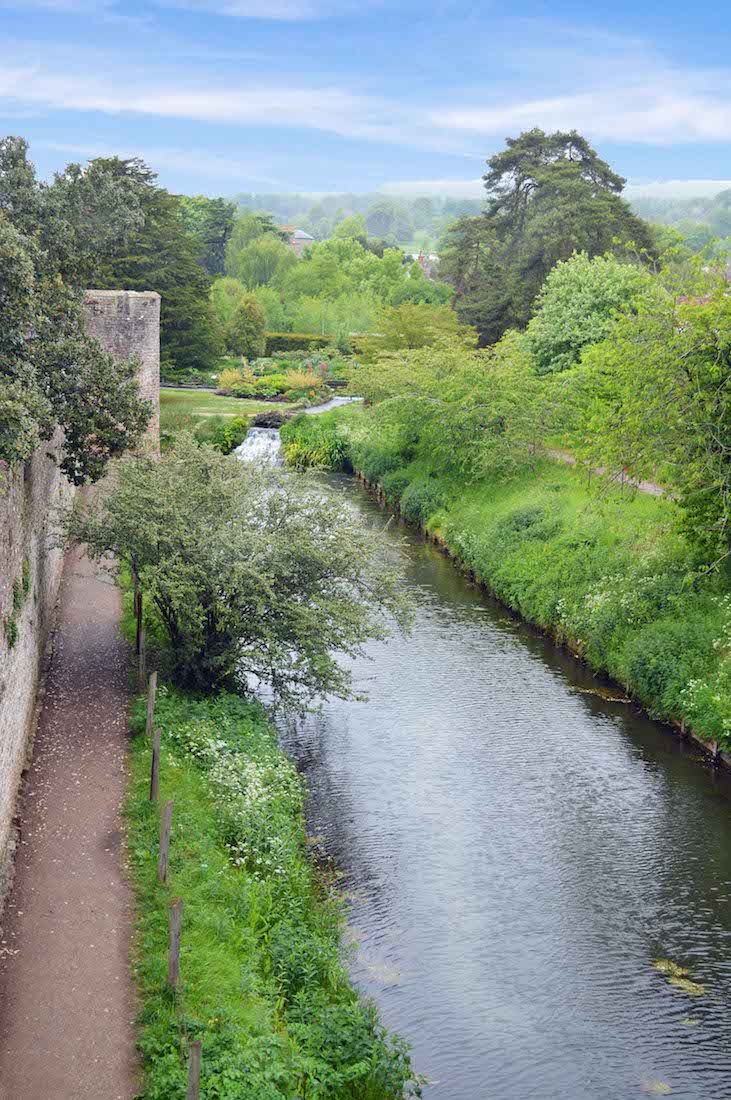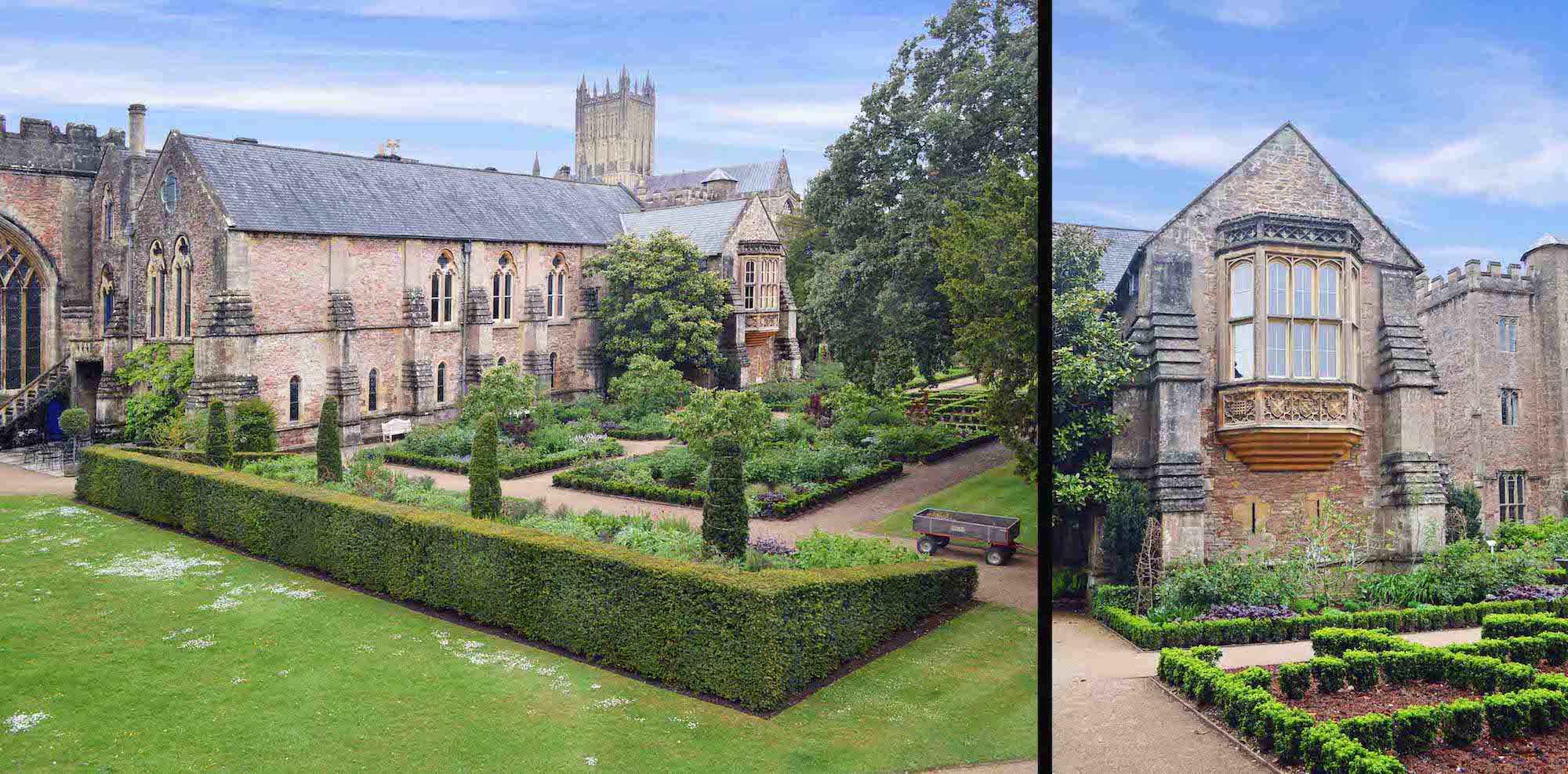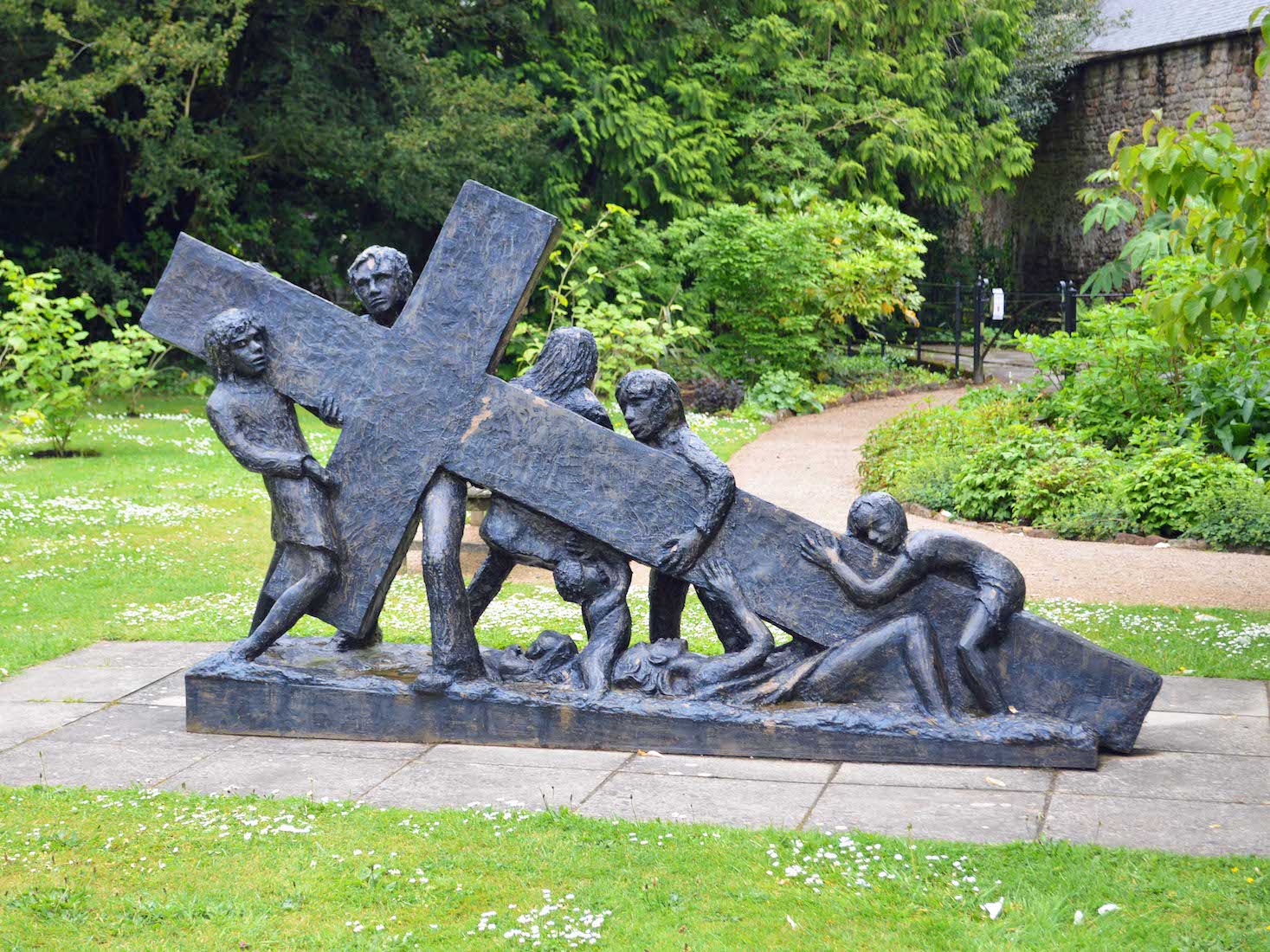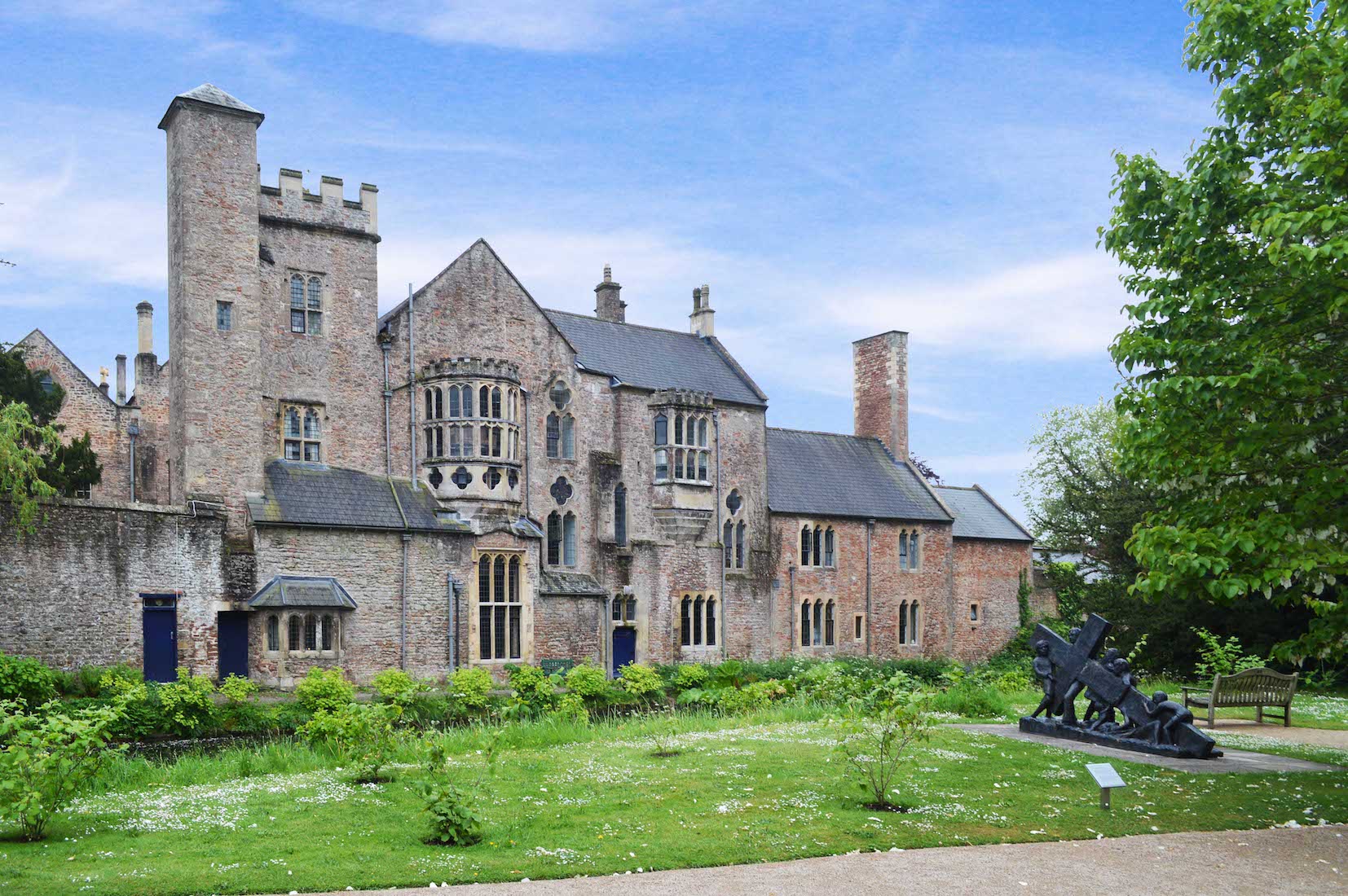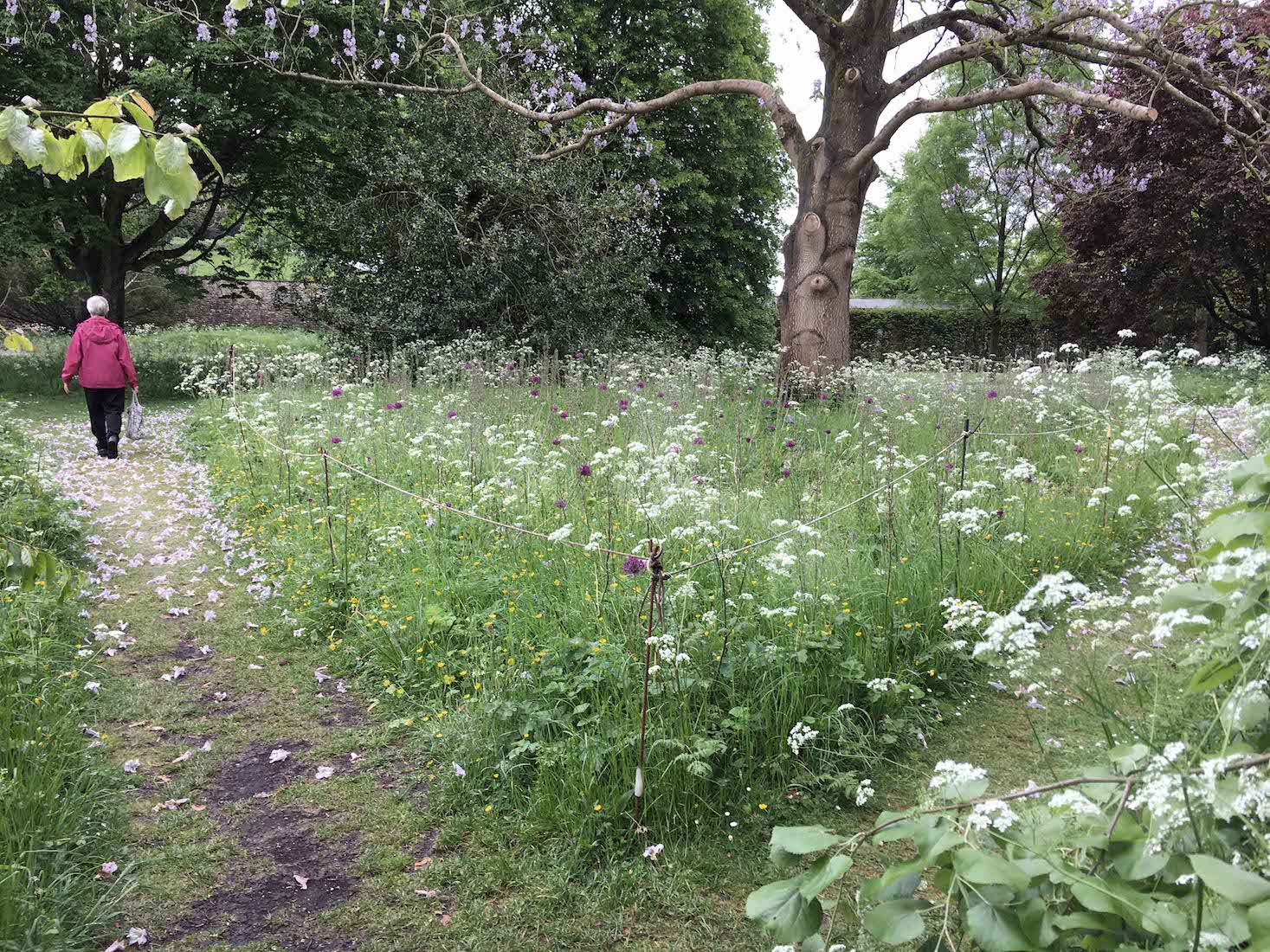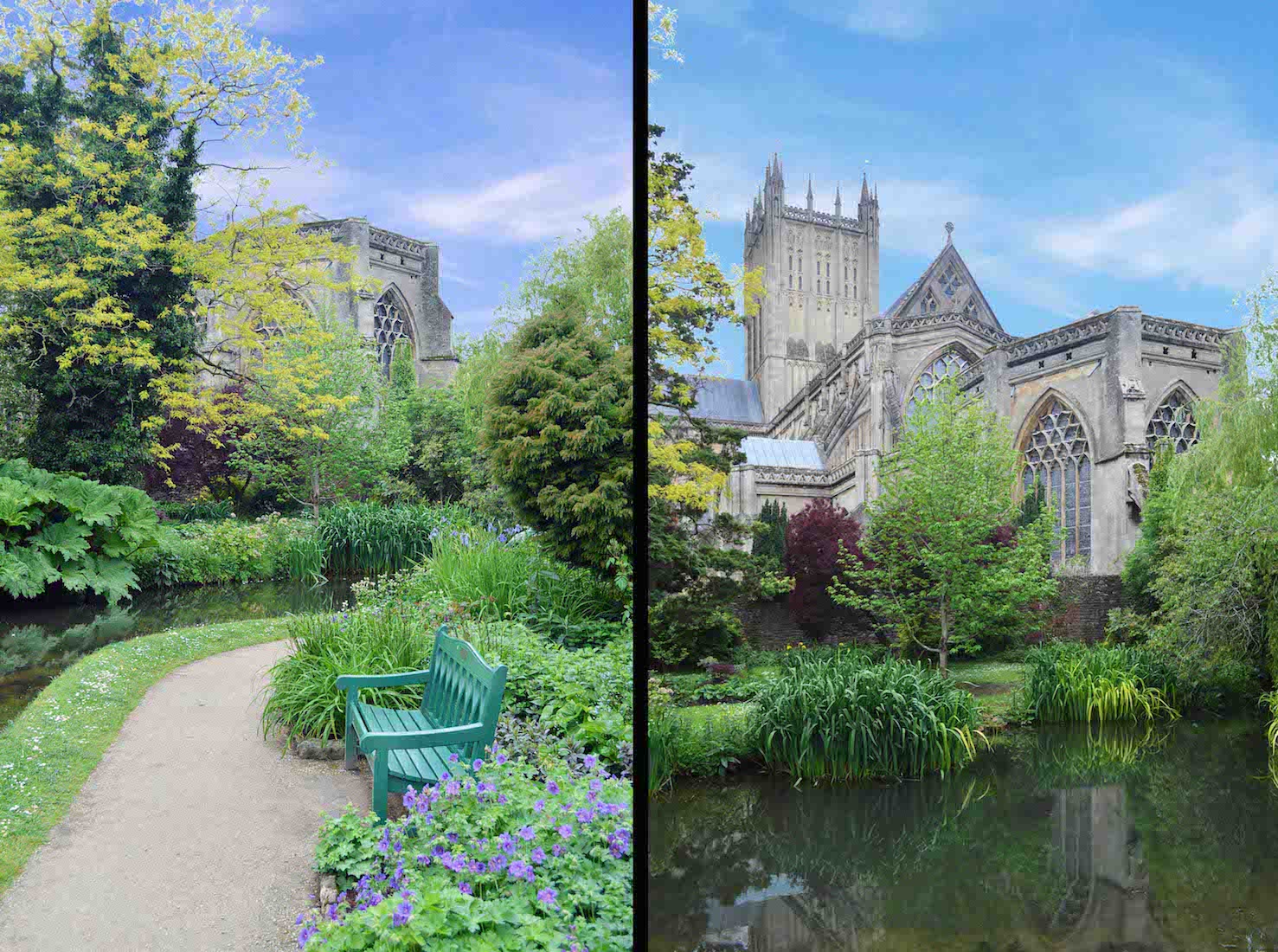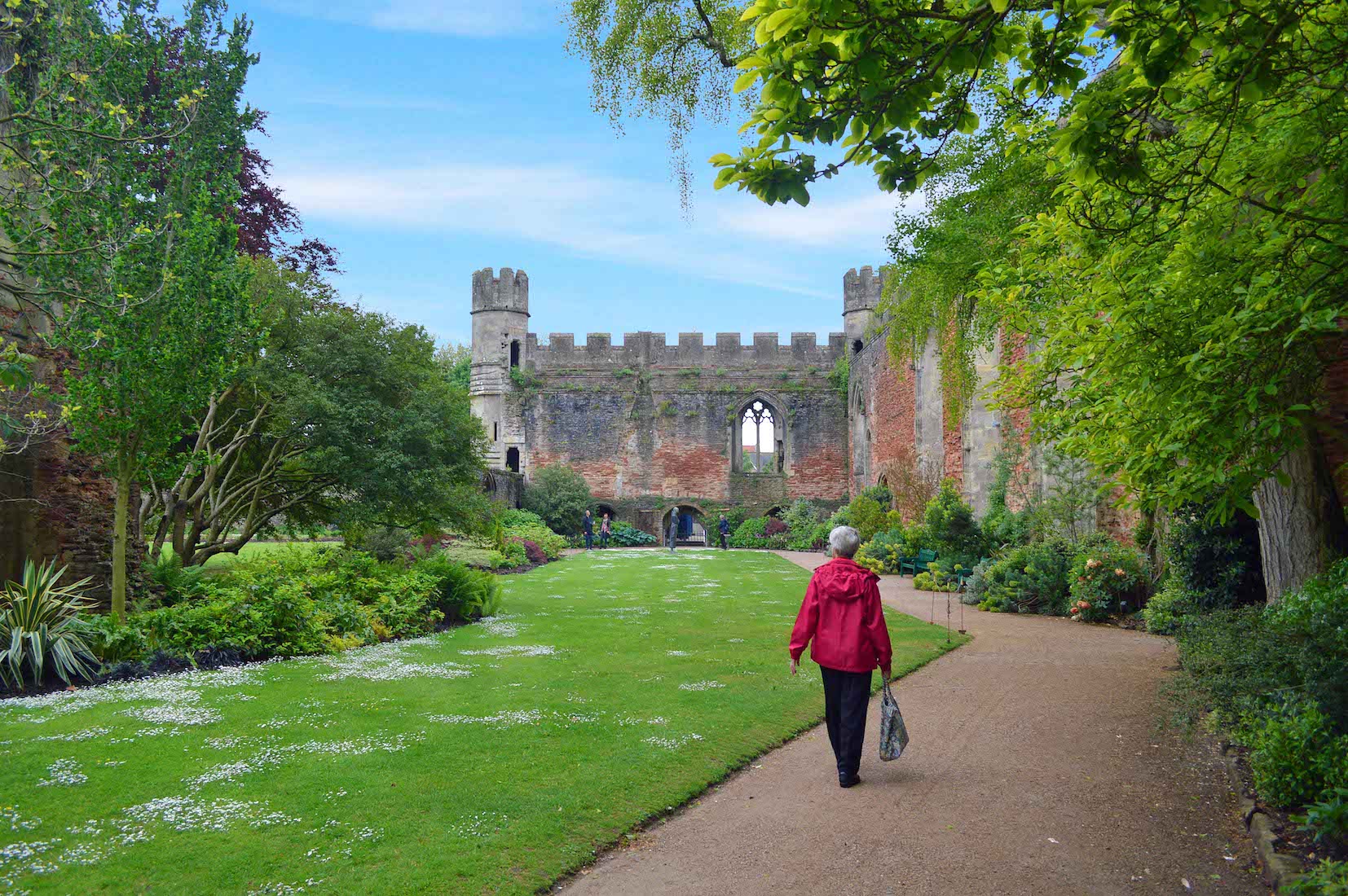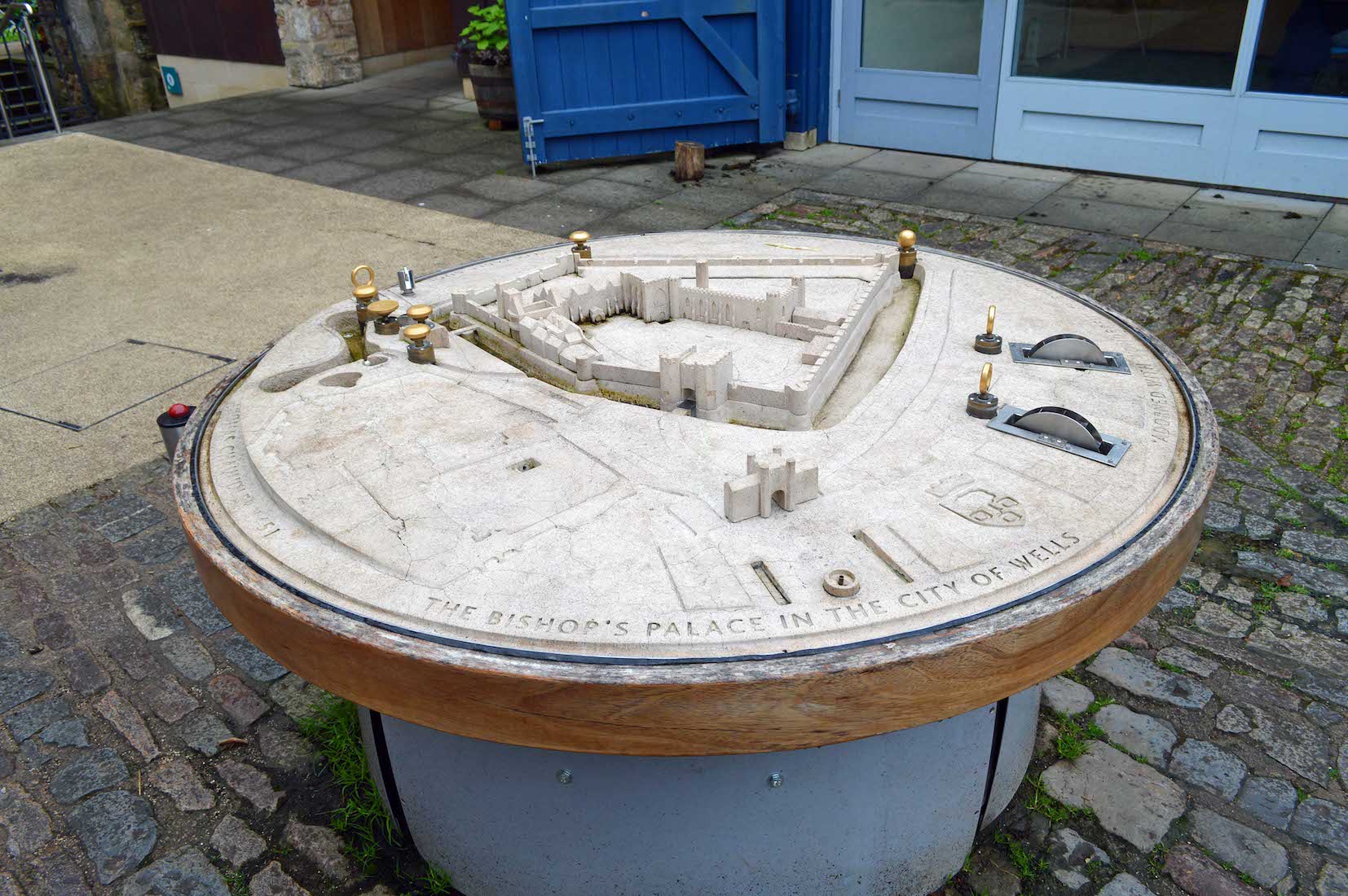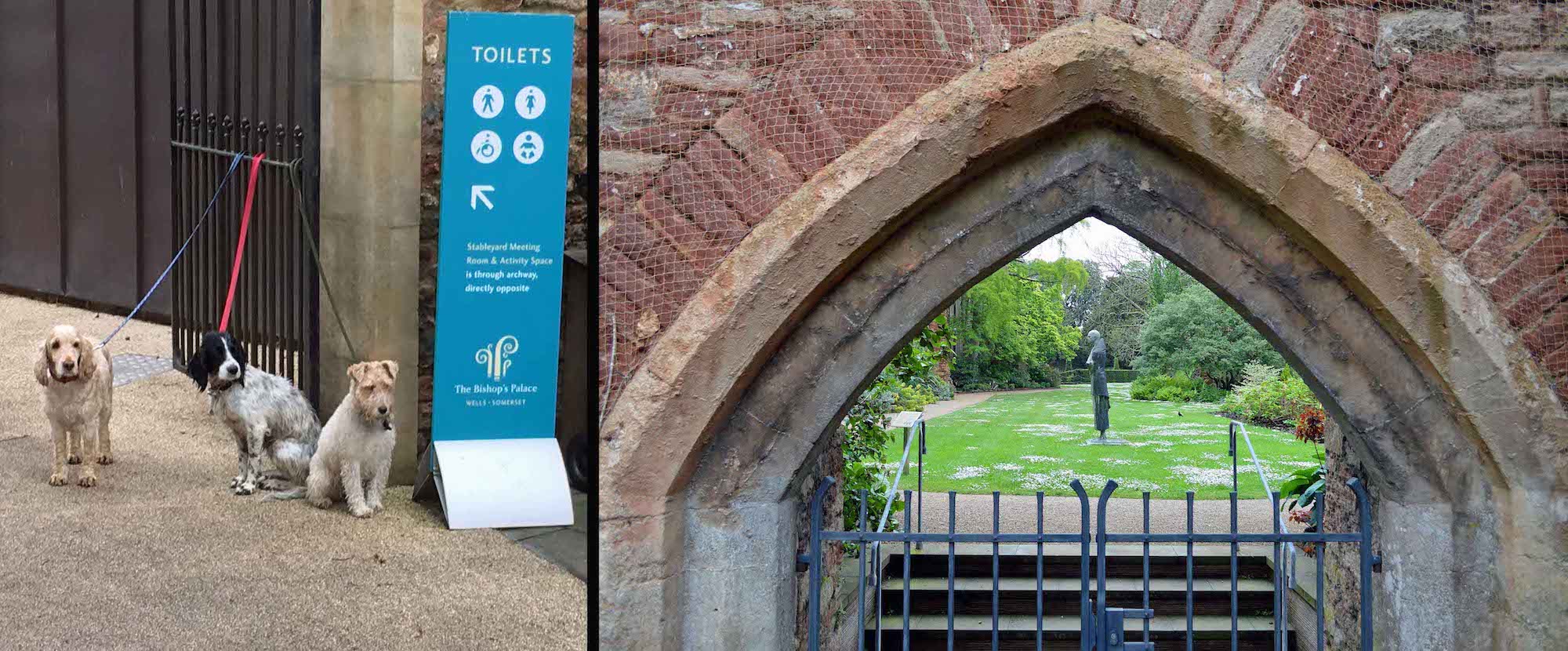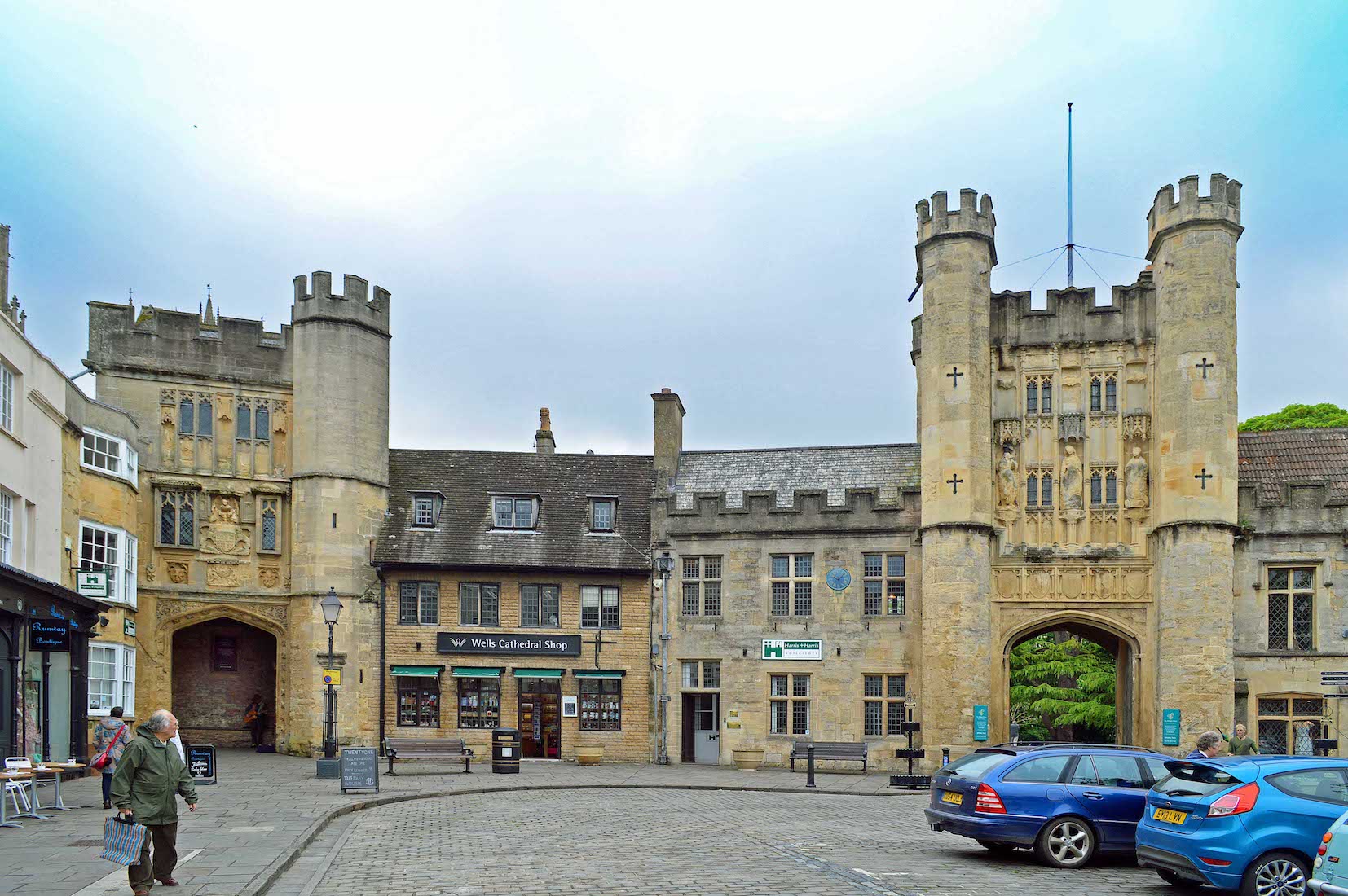
Wells Cathedral and the Palace Gardens lie almost due east of the Wells township, with High Street ending at the Cathedral gates. The gate at left leads us to the Cathedral itself, and the Cathedral shop is adjacent. The gate at right takes us through to the Bishop’s Palace Gardens. We shall investigate the Gardens first, but we notice that above the left gate there are some impressive, if rather weathered, coats of arms. PLAN
G2. THE TWO GATES
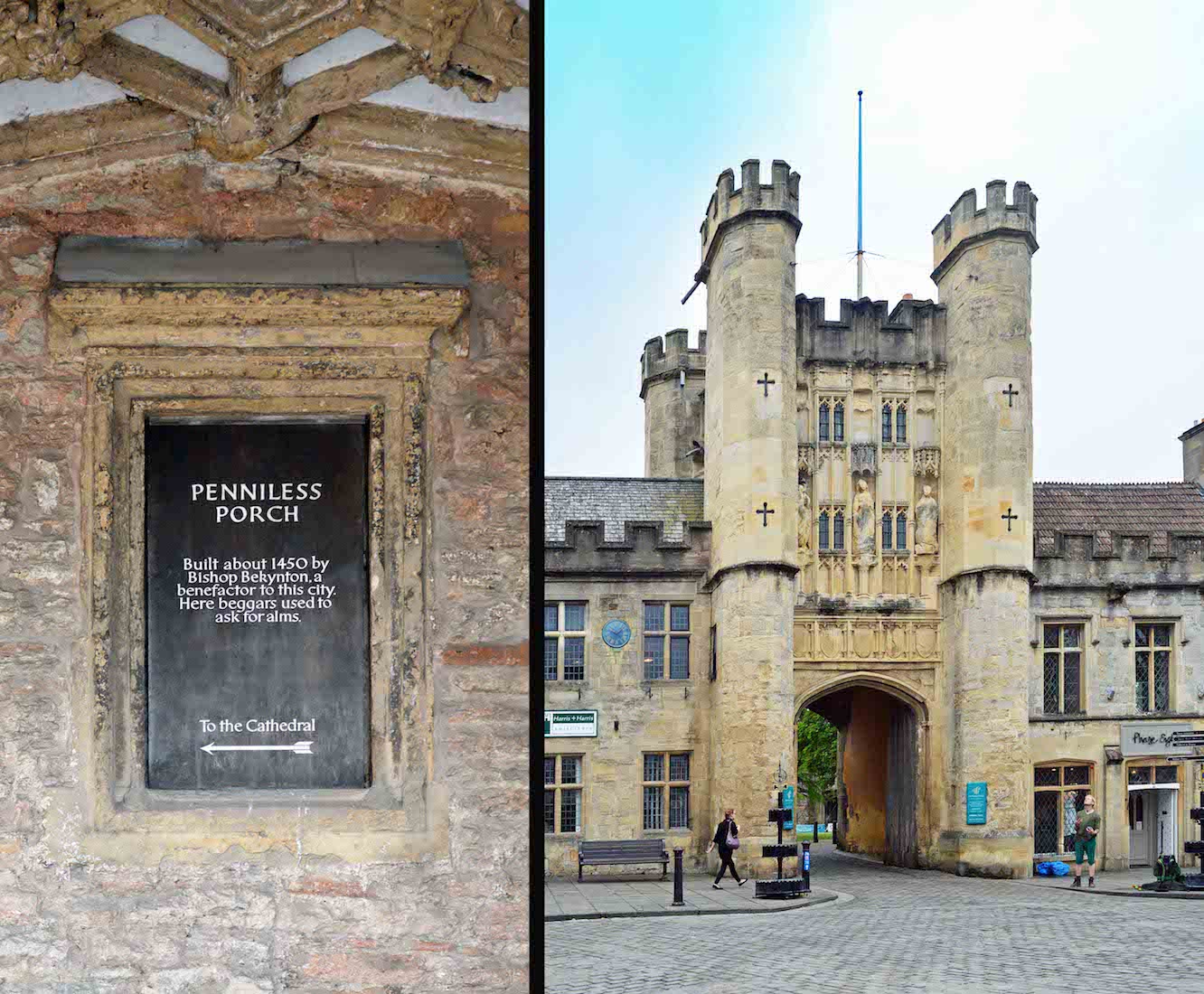
If we were going directly to the Cathedral we would pass through the Penniless Porch, built by Bishop Bekynton c1450. Here beggars used to ask for alms. The gatehouse entry to the Bishop’s Palace has rooms above, and some stone figures which are quite unrecognizable due to weathering. The lush green foliage entices us in!
G3. THE MOAT
The Bishop’s Palace and much of the lawned area is surrounded by a wide moat. The scene these days is quite serene with overhanging trees and a family of swans showing interest in any passer-by. On the other side of the moat the garden is bordered by a high defensive wall. The corners are marked by solid round bastions (as in this southern corner) with slits from which archers might fire their arrows.
G4. CATHEDRAL VIEW
If we look back in a northerly direction past this south bastion, we catch a glimpse of the Cathedral itself. This is such a delightful setting, and we have not yet even found the Palace! The Bishop’s Palace has been the home of the Bishops of the Diocese of Bath and Wells for 800 years.
G5. GARDEN GATEHOUSE
From the south bastion, it is a short distance to the Garden Gatehouse with its access bridge across the moat. Building of the palace started around 1210 by Bishops Jocelin of Wells and Reginald Fitz Jocelin. The chapel and great hall were added by Bishop Robert Burnell between 1275 and 1292. In the 14th century Bishop Ralph of Shrewsbury had an uneasy relationship with the citizens of Wells, partly because of his imposition of taxes, and surrounded his palace with protective crenellated walls, a moat and a drawbridge.
G6. TIME TO ENTER!
We approach the Gatehouse and cross over the drawbridge. There is a moderate fee to enter, but the ticket allows for return visits on the day. The palace was originally surrounded by a medieval deer park. When the walls were built, streams were diverted to form the moat as a reservoir. In the 1820s, the grounds within the walls were planted and laid out as pleasure grounds by Bishop George Henry Law, who created a reflecting pond near the springs.
G7. THE BISHOP’S TABLE
As we have spent the early part of the day travelling from Bristol to Wells by bus, our first point of call is the café called The Bishop’s Table. This has a fine selection of food and drink, and a very pleasant window wall facing out across a large lawn to the Palace itself. Toilet facilities are close by.
G8. VIEW TO THE PALACE
Straight ahead of us across the lawns is the Bishop’s Palace which is open to the public. A little left of centre is the Chapel, and to the right is the remaining wall of the Great Hall. Near the blue sign is the entrance through to the section of garden beyond the wall. We feel we have insufficient time to visit the Palace: I regret this, but we prefer not to be rushed in our visiting.
G9. THROUGH THE GREAT HALL ARCH
We continue with our exploration, passing through the arch in the wall of the great hall, and entering an open lawned courtyard. A statue stands guard here. This is ‘The Pilgrim’ – a statue by Somerset artist David Backhouse. ‘This sculpture is inspiring in its own right, and also changes the way you look at the setting. The pilgrim seems to both belong here, and to be passing through’ (Dee Price).
G10. LOOKING BACK ON THE GREAT HALL WALL
In the 1550s, Bishop Barlow sold the lead from the roofs of the great hall. This resulted in it falling into a ruined state. It can be seen in an engraving of 1733 but was largely demolished around 1830 by Bishop Law. He created a ‘more picturesque ruin’ by removing the south and east walls and laying out and planting the area previously occupied by the great hall.
G11. TOWER AND PALACE
We walk around towards the north bastion, and the back of the palace comes into view. The palace has an interesting history. It was used as a garrison for troops in both the English Civil War and Monmouth Rebellion, and later as a prison for rebels after the Battle of Sedgemoor. In 1703 Bishop Kidder was killed during the Great Storm, when two chimney stacks fell on him and his wife, while they were asleep in bed. A central porch was added around 1824 and, in the 1840s and 1850s, Benjamin Ferrey restored the palace and added an upper storey. He also restored the chapel using stained glass from ruined French churches.
G12. MOAT
Standing atop the north bastion we look westwards along the moat. There are now 14 acres (5.7 ha) of gardens including St Andrew’s Spring from which the city takes its name. The spring supplies St. Andrew’s Well from which water flows at a rate of 40 imperial gallons (180 L) per second into the moat which holds 4 million imperial gallons (18,000,000 L). The water emerging from the spring originates from the cave system of the Mendip Hills.
G13. BACK OF PALACE
The palace is a two-storey building of seven bays, with three gables over alternating bays, two of which are supported by buttresses. There is an attic beneath the coped gables and surmounted by octagonal chimney stacks. The interior is laid out with a hall, solar (upper chamber) and gallery with an undercroft. It has flagstone floors and a 16th-century stone fireplace.
G14. CATHEDRAL VIEW
Arriving at the north-western bastion, we gain a view across the moat to the Cathedral. We note the central tower and the South transept. In the foreground is a metal sculpture with a discernible Cross. At right we catch a glimpse of the Well House which was built in 1451 for Bishop Beckington to provide water to the citizens of Wells. The small stone building with a slate roof has a central hole in the stone floor giving access to the well itself.
G15. SCULPTURE
‘The Weight of Our Sins’ is a sculpture by the late Josefina De Vasconcellos, and was gifted to the Bishop's Palace, by Prof G. Romaine Hervey in memory of the sculptor, his friend. The sculpture shows eight children, and they depict the wrongs the children of the world still suffer: Child & Sexual Abuse, Famine, Aids, Infanticide, War & Land Mines, Genocide, Child Labour, Homeless & Drug Abuse. Christians believe that the Nazarene gave His life for Man’s sins. So, what does this mean?
G16. PALACE WEST WALL
Even when seen from the ‘business side’, the Palace is a grand building. Parts of the buildings are still used as a residence by the current bishop, however much of the palace is now used for public functions and as a tourist attraction.
G17. CATHEDRAL VIEW ACROSS THE REFLECTING POOL
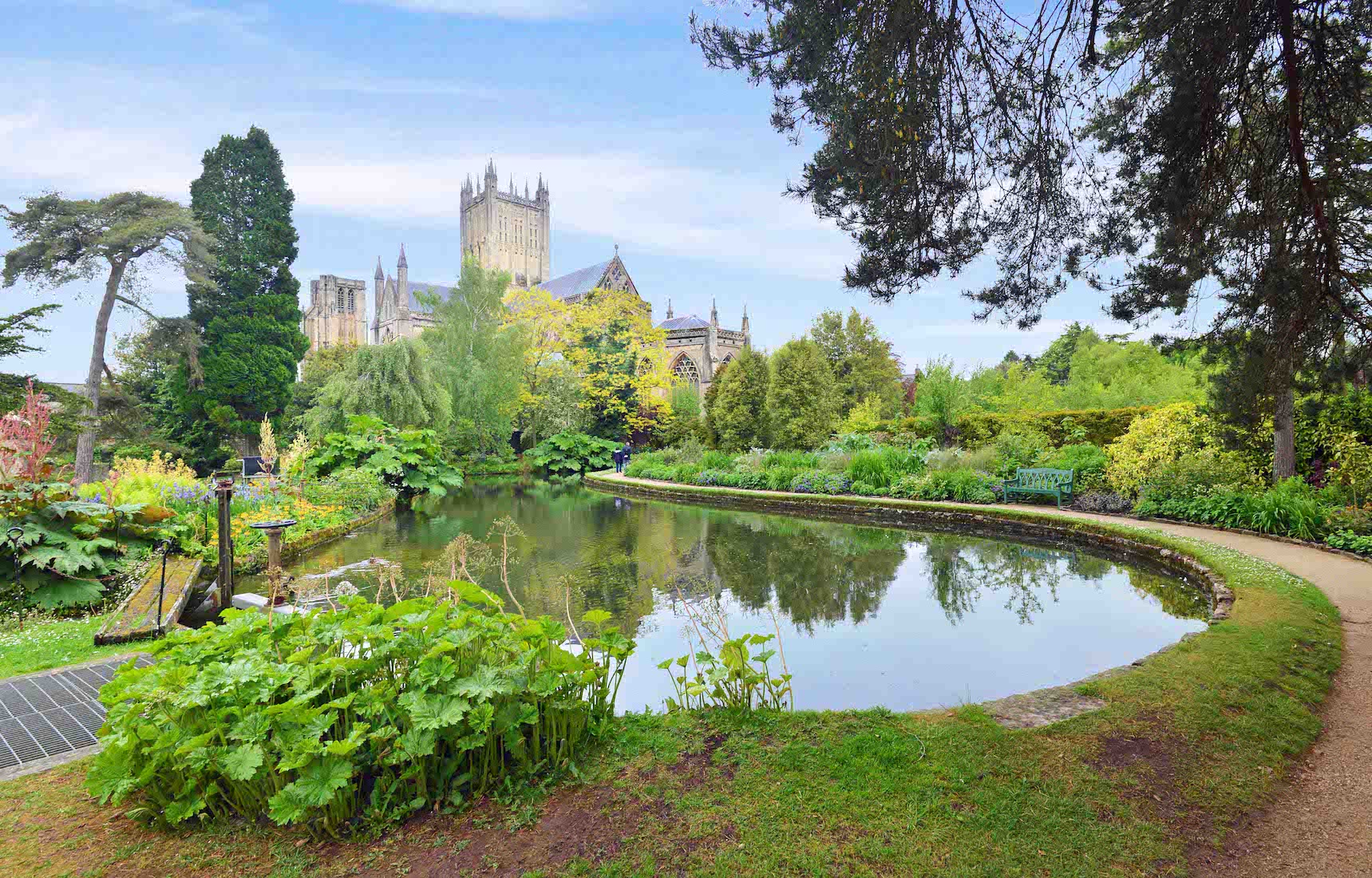
In the 1830s, Bishop Law had a pool created next to the springs. This acts as a mirror on a still day providing reflections of the East end of the Cathedral in the water.
G18. FLOWER MEADOW
The gardens north of the Palace and across the moat are rather wilder. We go looking for the Dragon’s Lair, walking across a beautiful meadow of wild flowers.
G19. DRAGON’S LAIR
There is no sign of St George in this children’s area, but ‘legend has it that in the 12th century, Somerset was terrorised by a frightful dragon who liked to eat milkmaids and other unsuspecting villagers. Bishop Jocelyn, who built the Bishop’s Palace, bravely ventured out to kill the dragon. ... ’. The play area is quite small, but an interesting feature is the hand operated pump and waterwheel which sends water out along a wooden channel.
G20. MORE CATHEDRAL VIEWS
The western pools curve around quite close to the Cathedral’s Lady Chapel. Here we ‘look in’ to the Eastern end and the Lady Chapel. Later we shall find a place within the Cathedral precinct to ‘look out’ across the springs.
G21. LEAVING THE PALACE GROUNDS
The Palace gardens are certainly a place to linger, but the Cathedral calls. We make our way back past the great hall, and through to the Café for lunch.
G22. PALACE GARDEN WATER FEATURE
Near the Café is a stone model of the Palace and the surrounding gardens. It was designed to allow water to be circulated around the moat, but my memory is that this feature was not working on the day of our visit. Such models need constant maintenance – rather like cathedrals!
G23. TOILET STOP
Toilets are always a welcome find for the tourist, and these are close to the Café. These canines wait patiently for their owners’ return, and I find an unexpected view across the gardens past the meditating pilgrim. This completes our tour of the Palace Gardens; now it is time to leave and explore the Cathedral.


